

Canon EOS 1D MkIV Review
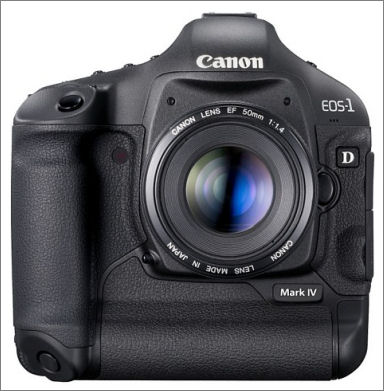
The Canon EOS 1D Mark IV was announced in October 2009 and (as of 07/10) is the latest offering in Canon's 1D series of professional DSLRs. The 1D series cameras are optimized for fast operation and have traditionally been the camera of choice for sports professionals who shoot with Canon. 1D series use an APS-H format sensor (28.1x18.7mm), which is larger than APS-C and so can yield higher image quality, but is smaller than full frame, which means that the file size is smaller and the reflex mirror can be smaller and lighter. This enables the camera can operate at higher speeds (10 frames per sec). Like other professional 1D and 1Ds series cameras, the EOS 1D MkIV has an integrated grip with a second set of controls for vertical shooting and is weather-sealed for operation outdoors in the rain. It also utilizes a high capacity battery pack and has high strength construction to make it rugged enough to stand up to hard professional use.
Major Features of the Canon EOS 1D MkIV
- 16.1 Megapixel APS-H CMOS sensor
- Upgraded AF system for optimal high speed tracking of moving subjects
- Up to 10 frames per second continuous shooting
- 45-point wide area AF with 39 cross-type sensors with f/2.8 sensitivity
- Buffer holds 121 large JPEG images in a single burst
- 12,800 high ISO - expandable to ISO 102,400
- Dual High-speed “DIGIC 4” processors for fast operation and high image quality
- HD movie recording at 30, 25 and 24 frames per second (fps)
- 3.0" Clear View II LCD with Live View mode
- Dust and water resistant body (with 76 rubber seals)
- 1/8000s maximum shutter speed rated for 300,000 cycles with a 1/300s sync
- Size: 6.1 x 6.2 x 3.1 in./156 x 156.6 x 79.9mm
- Weight: 1180 g / 41.6 oz (2.6 lbs)
The full details of the Canon 1D MkIV can be found on the 1D MkIV Specifications page.
Physical Construction
The EOS 1D MkIV is a relatively large and heavy camera. The integrated grip and high capacity battery significantly increase the size of the camera body when compared to an EOS 5D MkII and it's much bigger and heavier than something like a digital Rebel T2i. The 1D MkIV wouldn't fit either my LowePro Off Trail bag or my LowePro Mini-Trekker backpack. At just over 2.5lbs in weight it's also pretty heavy - and that weight doesn't include a lens!
.jpg)
Of course the size and weight are a consequence of the sturdy construction and other features required for serious professional use. The grip is integrated to add strength and reliability. With an integrated grip there are no worries about body-to-grip contacts or providing a place where dust and moisture can enter the camera - plus there's no weak mechanical coupling to fail if the camera is dropped or otherwise abused. The chassis of the Canon 1D MkIV is all metal and is environmentally sealed using 76 different rubber seals and gaskets. All of this adds to the size and weight of the camera.
Controls
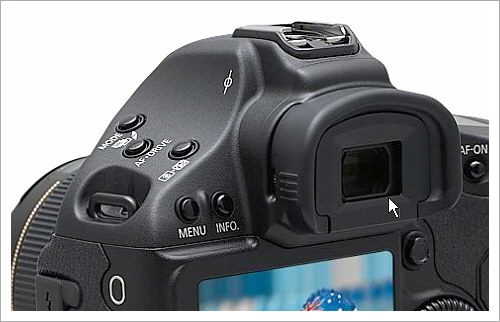
The control layout of the Canon EOS 1D MkIV is similar to that of other Canon EOS 1 series cameras (including film cameras). Operational mode is set via push buttons and the main control wheel rather than the dial used by prosumer models. Again this is related to durability and reliability. The dial is a potential weak point and it's easier to weatherseal a button than a rotary dial. On the left of the camera are the control buttons for setting the shooting mode, drive mode, AF mode, metering mode and flash exposure compensation, as well as additional buttons for displaying menus and selecting display information.
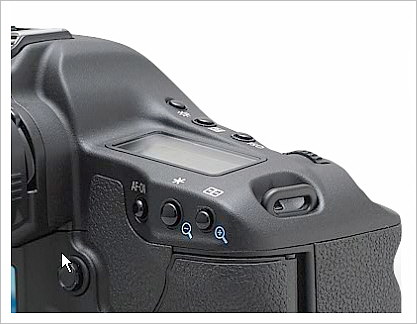
Over on the right are the control buttons for LCD illumination, exposure compensation, ISO setting and FEL (flash exposure lock). The FEL button is located next to the shutter release and multiple functions controlling multi-spot metering and starting and stoping the movie mode in live view. Buttons on the top right of the back control exposure lock, AF zone selection, AF start/stop and image magnification in playback mode. These buttons (along with the shutter release) are duplicated on the lower right side of the integral grip so they are available (and similarly positioned) when shooting in vertical (portrait) mode.
Viewfinder
The whole viewfinder assembly is pretty much identical to that used in the 1D MkIII. It has 100% coverage with approximately 0.76x magnification and a 20mm eyepoint. A dioptric adjustment of -3 to 1 diopters is built in and there is an eyepiece shutter to block off light during long exposures. The standard focusing screen is the Laser-matte Ec-C IV (the same as in the EOS-1D Mark III). It provides a clear image for easy focusing, excellent brightness, low "grain" and a natural looking background blur. It is user replacable by any of the series 1 Ec focusing screens if desired.
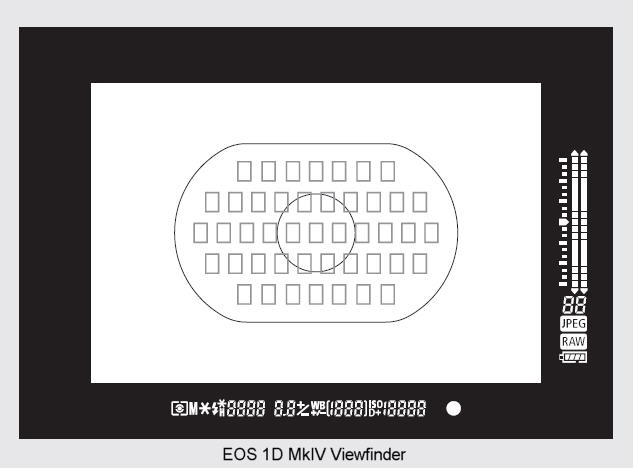
The viewfinder display has two parts, one horizontal display below the screen and the other vertical and to the right of the screen. The vertical display shows metering (including flash metering) and exposure compensation in 1/3 stop steps from +3 to -3 stops. It also shows indicators for JPEG and RAW file recording, maximum burst count and battery level. The horizontal display shows the usual EOS parameters such as shutter speed, aperture, ISO, highlight tone priority, shots remaining, flash status, metering mode, focus confirmation and white balance correction.
The viewfinder screen itself has a center circle showing the area covered by the spot meter as well as an outline of the area covered by the AF zones).
LCD
The Canon EOS 1D MkIV features a 3-inch LCD monitor with approximately 920,000 dots (VGA resolution), a wide (160°) viewing angle, high brightness and low power consumption. Colors and color reproduction have been improved over the old EOS-1D Mark III and more natural-looking images closer to the sRGB color space are obtained.
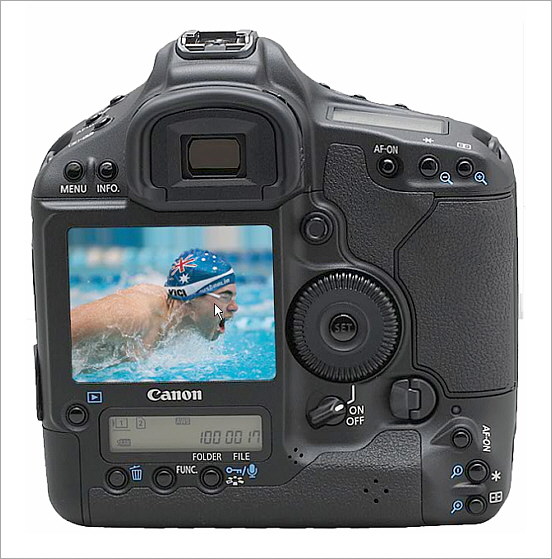
The protective cover over the LCD has been changed from plastic to reinforced glass to prevent any force applied to the protective cover from reaching the LCD panel. The new cover is also much more scratch resistant.
The Canon EOS-1D Mark IV's LCD screen has an anti-reflective and smudge-resistant coating and with internal technology which also reduces internal reflections. This results in a higher contrast image which is easier to see, even outdoors in bright sunlight.
A second small monochrome LCD below the main color LCD is used to display various items of camera status. There are indicators to show which type of media cards are in use, the white balance settings, the size and type of image recording (RAW, JPEG), information on file and folder numbers and indicators associated with wired and wireless LAN connections.
The top mounted LCD displays the usual EOS data including shutter speed, aperture, exposure compensation, shots remaining, battery status, ISO setting. metering, drive and AF modes, HTP and AEB status and mirror lock up status.
Operation and Timing
I tested the Canon EOS 1D MkIV using a 90 MB/s (600x) Sandisk Extereme Pro 16GB CF card. This card is UDMA 6 enabled and it's currently one of the fastest CF cards available.
With the camera set at 1/500s, ISO 100 and manual focus was fixed in RAW mode the buffer held 32 frames recorded at 10.0 frames per second (fps) before the shooting rate slowed. After the buffer filled the frame rate dropped to an average of about 3.5 fps.
With th ISO set to ISO 3200 and all other settings left the same, the buffer filled after 23 RAW images at 10.0 fps. After the buffer filled the average rate dropped to around 2 fps.
At ISO 100 and recording RAW + JPEG (highest quality and resolution) images, the buffer held 19 frames shot at 10.0 frames/sec after which the average frame rate dropped to around 2.5 fps.
Recording JPEG images at ISO 100 the frame rate was 10.0 fps. The buffer still hadn't filled after 20 seconds (200 frames), which is where I gave up!

Click for audio (MP3) file
ISO and Noise
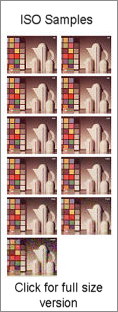 The Canon EOS 1D MkIV has an ISO range of 100-12,800 without expansion. With expansion enabled via a custom function, there are additional ISO settings of 50 (L), 25,600 (H1), 51,200 (h2) and a remarkable 102,400 (H3). There's also an auto ISO function ,customizable with the photographer's choice of upper and lower limits between ISO 100 and ISO 12800. Auto ISO functions in manual mode, so the photographer can set shutter speed and aperture and the camera will select the appropriate ISO setting for optimum exposure.
The Canon EOS 1D MkIV has an ISO range of 100-12,800 without expansion. With expansion enabled via a custom function, there are additional ISO settings of 50 (L), 25,600 (H1), 51,200 (h2) and a remarkable 102,400 (H3). There's also an auto ISO function ,customizable with the photographer's choice of upper and lower limits between ISO 100 and ISO 12800. Auto ISO functions in manual mode, so the photographer can set shutter speed and aperture and the camera will select the appropriate ISO setting for optimum exposure.
 The actual photosensitive area of the Canon D MkIV pixels is the same as that of the 1D MkIII, despite the higher pixel density (16MP vs. 10.1MP). This was accomplished via more efficient use of the sensor area by maximizing the photosensitive area of each pixel as well as the use of an improved fabrication process that yields a sensitivity gain. In addition a gapless microlens system and a higher transmission Bayer matrix color filter further improve light capture. The result is that in spite of a higher pixel density (and therefore a smaller pixel size), the Canon 1D MkIV shows a lower noise level than the 1D MkIII.
The actual photosensitive area of the Canon D MkIV pixels is the same as that of the 1D MkIII, despite the higher pixel density (16MP vs. 10.1MP). This was accomplished via more efficient use of the sensor area by maximizing the photosensitive area of each pixel as well as the use of an improved fabrication process that yields a sensitivity gain. In addition a gapless microlens system and a higher transmission Bayer matrix color filter further improve light capture. The result is that in spite of a higher pixel density (and therefore a smaller pixel size), the Canon 1D MkIV shows a lower noise level than the 1D MkIII.
Noise at low ISO settings is virtually absent and remains very low up to ISO 1600. At ISO 3200 noise is still low though some is visible. Even at ISO 12800 image noise is acceptable for many applications. Once ISO goes into the expanded range things do get worse though. ISO 25600 is noisy but not too awful, but at ISO 51200 noise is clearly degrading the image and at ISO 102400 noise and image degradation due to noise reduction makes this strictly an "emergency only" setting.
Overall I'd say that the noise level of the Canon EOS 1D MkIV is pretty similar to that of the EOS 5D MkII through ISO 6400 and is at least one stop better than the noise level of the EOS 7D. At ISO 12800 and 25600 the Canon 1D MkIV shows the lower noise than the 5D MkII.
Flash
Like all the professional 1 series EOS cameras, the Canon EOS 1D MkIV doesn't have a built in flash. There are probably several reasons why a pop-up flash isn't used. First lack of space in the pentaprism area and second, better weather-sealing since a pop-up flash gives more areas for water and dust penetration. A pop-up flash is also susceptible to damage so a sealed pentaprism unit leads to a tougher camera. There is the standard EOS hotshoe and a PC flash connector. Maximum sync voltage is 250v and maximum sync speed is 1/300s for small compact flashes. Sync speed may be slower with large studio flash systems. Flash exposure microadjustment is provided.
There is no built in wireless flash control. A wireless master speedlite or wireless flash controller must to mounted to the hot shoe if you want to use wireless flash.
Autofocus
Autofocus has been something of a thorn in the side of Canon when it comes to the 1D series cameras. More specifically the EOS 1D MkIII, which preceded the EOS 1D MkIV had some problems. While many users were delighted with the AF and had no problems, others found fault with operation with AF tracking of moving subjects under certain sets of conditions. Canon offered repairs on the sub-mirror assembly of some cameras which had a problem and several firmware updates were issued to address AF tracking issues. Canon also recalibrated the AF system on some cameras returned to them for AF tracking problems.
Despite these issues, many photographers had no problems and the AF system of the EOS 1D MkIII was very, very good under most conditions and the camera was widely used by professional photojournalists and sports photographers. It wasn't 100% perfect 100% of the time, but nothing ever is. However the problems got a lot of press and the reputation of Canon took a bit of a hit in some quarters.
Given the legacy of the controversy concerning the 1D MkIII, it's likely that Canon put a LOT of work into developing the AF system of the EOS 1D MkIV. Again most users seem to be very happy with it. I was certainly very happy with it and I'd say it's the best AF I've ever used- but there are still the inevitable voices out there claiming tracking AF isn't perfect.
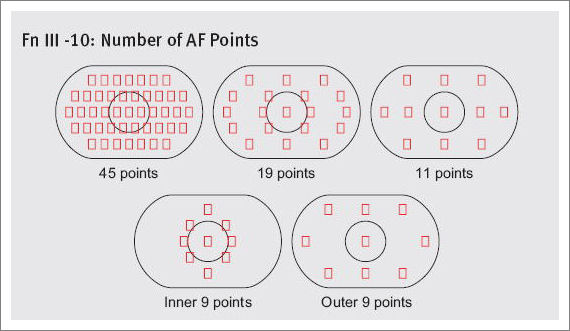
The 1D MkIV AF system is quite complex. It has 45 zones, 39 of which can be manually selected. 19 zones are used when the camera auto selects the AF point, All 39 zones have cross sensitivity. The center AF zone is a cross type with vertical AF sensitivity up to f4 and horizontal sensitivity up to f/8. That means that lenses up to f/8 (e.g. f/4 with a 2x TC) can be autofocused using the center AF zone (horizontal sensitivity only). The other AF zones have vertical sensitivity up to f/2.8 and horizontal sensitivity up to f/5.6, which means they act as cross sensors for lenses f/2.8 and faster and horizontal sensors for lenses slower than f/2.8.
However (and I did warn that the AF system is complex), the following lenses--although f/4 maximum aperture--allow the 39 AF zones to act as cross sensors, even though they are not f/2.8. Don't ask me how or why...
- EF 17-40mm f/4L USM
- EF 24-105mm f/4L IS USM
- EF 70-200mm f/2.8L IS USM + Extender EF1.4x II
- EF 200mm f/2L IS USM + Extender EF2x II
- EF 300mm f/2.8L IS USM + Extender EF1.4x II
- EF 400mm f/2.8L IS USM + Extender EF1.4x II
Canon goes in to say "During manual AF point selection, the six single-axis AF points (or 26 AF points during automatic AF point selection) other than the 39 cross-type AF points will work as horizontal line-sensitive sensors at maximum apertures up to f/5.6. They have the same detection performance as the EOS-1D Mark III's assist points working at maximum apertures up to f/5.6. The two AF points at the immediate top and bottom of the center AF point have improved detection performance and precision due to the doubling of the number of lines for the f/5.6 sensor". Like I said, complex.
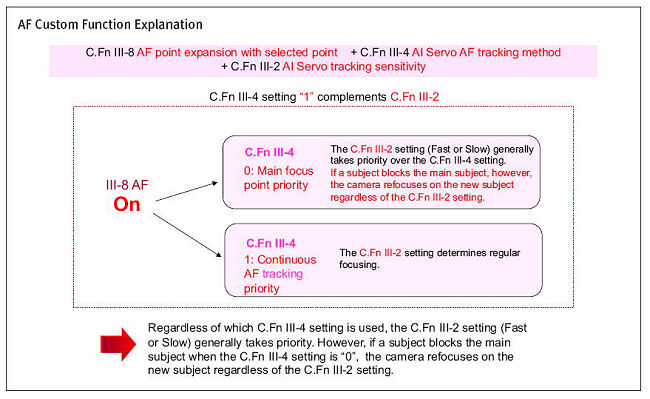
Even when you've understood all the hardware, you have a choice of several custom functions which can be used to tailor the AF system to your exact liking. You can select the number of AF zones used, the sensitivity to interference from objects moving between the camera and subject, whether AF or drive speed or tracking has priority for the first frame in a continuous sequence, You can also select which (if any) AF points come into play and assist if the chosen AF point loses focus on the subject. For a beginner, the number of options would probably overwhelm them.
Autofocus microadjustment is provided enabling fine tuning of focus, which can be stored on a lens by lens basis, or the same adjustment can be applied to all lenses.
AF Testing
There are really no standardized tests for AF operation as there are for resolution tests. There's no such thing as an AF test target. AF depends on the light level, the contrast level of the subject, the speed at which the subject is moving, the direction in which the subject is moving, the consistency of subject motion (smooth or jerky), how well the photographer keeps the subject in the AF zone and so on. It also depends how the photographer has setup the AF system, which includes selection of AF zones, whether the first shot is set to shutter or focus priority, what the sensitivity to brief obstruction of the subject is and so on. The whole AF operation of the EOS 1D MkIV is highly customizable, which means that you can set up up right but you can set it up in a manner that's not well optimized for the type of focus tracking you want to do.
So I'm not going to make any absolute judgment on just how good the AF system is, mainly because I'm not really qualified to do so. The only people who can pass judgment on it are working sports professionals who shoot thousands of action shots every week with different cameras (including the old 1D MkIII). Only those with such extensive experience are really in a position to pass judgment on whether Canon have gotten it right.
Top Left: Initial lock on target Top Right: 10 frames later, AF still locked onto target Bottom Left: 10 frames later, AF still locked even though obstruction has entered field Bottom Right: 10 frames later, AF still locked on target despite obstruction blocking most of it |
As I said, my experience with the AF system was very positive. AF was fast and accurate. I did some tracking AF tests at 10 fps on moving cars, with the cars moving at around 30-40 mph, and a Canon EF 300/4L USM lens. I also looked at the situation where the subject is partially obscured by a closer object to see if the AF system could hold focus lock on the moving subject (and it could!). I really can't fault the AF system, but as I said, I'm not a sports professional and I simply don't have enough experience to make meaningful comments on how well the AF does compared to the 1D MkIII and other cameras optimized for high speed work such as the Nikon D3. For those comments you'll have to look elsewhere. I can say that in the the tests I performed I found the Canon 1D MkIV AF to be fast and accurate and I had no complaints about its ability to track moving subjects.
Metering
The Canon EOS 1D MkIV uses the same 63-zone metering sensor as the 1D MkIII but different firmware is used to optimize correlation with the 45 AF zones of the 1D MkIV. The usual metering modes are available: Evaluative, Partial (13.5%), Spot (3.8%) and Center-weighted averaging. The evaluative metering algorithm of the 1d MkIV has been tweaked for more accurate results. The E-TTL II flash metering algorithms have also been tweaked for better exposure by using distance information to minimize the influence of the subjects clothing color, size etc.
A spot averaging mode is provided where you can take up to 8 spot metered readings and the exposure will be set to their average value.
As might be expected, I didn't find any problems with metering in normal use of the camera. The vast majority of shots were very well exposed. However, if your tastes differ from those of the Canon engineers, standard levels for metering and flash exposure can be adjusted by the user. The standard metering levels can be changed via a custom function using AE microadjustment in 1/8 EV steps over a range of +/- 1 EV and flash exposure can be similarly adjusted using FE microadjustment.
Normal exposure and flash exposure compensation is possible over a +/- 3 stop range in 1/3 stop steps.
Live View
In live view mode focus via contrast detection or phase detection is possible. Phase detection ("Quick" AF mode) requires the mirror to be flipped up and uses the focus system that is used for still images, but it is fast and accurate. Contrast detection ("Live"AF mode) is done using the live image and does not require the mirror to flip down but it can be rather slow (though it is faster than on the EOS 5D MkII due to firmware changes). A face detection mode is also available, which also uses contrast detection. The AF zone used for contrast detection can be user selected if desired.
By default, Live View is selected and deselected by pressing the "Set" button in the center of the quick control dial. The LCD image can be magnified by 5x or 10x to assist when using manual focus.
Video
The Canon EOS-1D Mark IV has excellent "broadcast quality" video capture. Video recording can be stopped and started using a single button, though there is no dedicated video button as there is on the EOS 7D. On the Canon EOS 1D MkIV you have to first select the "movie" option from the Live View menu. Then you can start and stop video using the FEL (flash exposure lock) button. Video can be viewed directly on compatible HD-ready TVs via the mini HDMI output. Any Canon EOS compatible lens can be used and if the lens has image stabilization, IS can be used during video recording. Due to the file system used on the memory cards, the maximum clip length is 4GB, the same as the maximum singe file size on any FAT 32 formatted volume. When shooting at lower resolution, clip length is limited to a maximum of 30 minutes, even if the file is under 4GB. 4GB is about 12 minutes of HD video or about 24 minutes of VGA video.
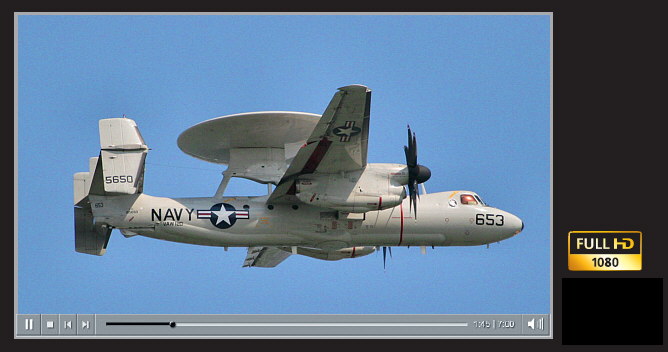
Center-Weighted average metering is used when shooting HD video in AE modes to help ensure stable motion-picture exposure with the camera automatically selecting the ISO speed, shutter and aperture. Full manual exposure control (shutter, aperture, ISO) is also available while shooting video when the camera is set to Manual mode. The shutter speed can be set from 1/30s for up to 30fps 1080 video, or from 1/60s for up to 60fps video. Maximum shutter speed for video is 1/4000s (it's 1/8000s for still images).
Video can be captured at full 1920 x 1080 resolution at frame rates of 24 (23.976), 25 or 30 (29.97) frames per second, for up to 4GB per clip. Movies are saved as MOV files and can be viewed in Full HD with HDMI output. Other recording sizes include HD at 1280 x 720 (50/60 (59.94) fps) or SD/VGA at 640 x 480 (50/60 (59.94) fps). The EOS-1D Mark IV has a built-in microphone for simple mono recording and stereo sound can be recorded through a self-powered external microphone.
As with all current DSLRs with video, focus via AF is set at the beginning of the exposure and there is no option for continuous focus tracking. Manual focus can be used and indeed it's the best option if you know that you will need to change focus during shooting. While it's possible to do "one shot" AF during shooting, focus will be slow and it will be likely to "hunt" if contrast detection AF is used.
If you intend to shoot high resolution video (1080 HD) you will need a reasonably fast memory card to keep up with the data that the camera generates (about 330MB/min). The SanDisk Extreme Pro UDMA 6 cards seem to work well.
For any serious video work with sound you'll want an external microphone. While the built in mono mic is OK, it can be susceptible to wind noise. A quality external stereo microphone will be capable of recording much better audio.
Peripheral Illumination Correction
While Canon has offered peripheral illumination correction (also known as vignetting correction) in DPP when doing conversions from RAW image files for quite a while, the Canon EOS 1D MkIV can apply the same corrections to in-camera JPEGs when certain Canon lenses are used. The camera has a database of about 20 Canon lenses. The Canon OS Utility software can be used to check which lenses are in the database and to add others for which the data is available.
Highlight Tone Priority
The Canon EOS 1D MkIV includes a highlight tone priority (HTP) setting. This reduces the clipping of bright highlights. It appears to work by using a nonlinear amplifier gain setting to the sensor data, which effectively could be considered to be the equivalent of shooting the highlights at an ISO setting about one stop slower than the shadows. HTP can be used with ISO settings from 200 to 12800. HTP can be effective at increasing highlight detail, at the possible cost of slightly noisier shadows.
Note that HTP is applied to the image before the RAW file is saved, so it's one of the few functions that can't be applied during RAW conversion. Functions like noise reduction, peripheral illumination correction, white balance etc. are not applied directly to the RAW file (only to JPEG files) and can be performed later in DPP, whether or not they were selected at the time of shooting.
Self Cleaning Sensor
The sensor cleaning system of the Canon EOS 1D MkIV includes a “fluorine coating” on the low pass filter (I presume this is a fluoride coating, since fluorine is a corrosive gas). This is said to provide “better dust resistance”. The sensor uses an ultrasonic shaking mechanism to shake any dust particles off the low pass filter when the camera is turned on and off. The position and size of any dust stuck on the sensor can also be saved as reference "dust delete data" and this data can be used for removal of dust spots using post processing with Canon's DPP software.
Auto Lighting Optimizer
The Auto Lighting Optimizer function analyzes the image and can optimize the brightness and contrast to improve the image (e.g. it can correct for dark subjects in back light situations). There are 4 levels: off, low, standard, and strong. This function can also be applied to RAW images during post-exposure processing using Canon's DPP software.
The effect of the auto lighting optimizer is subtle. On some images, it makes no difference at all, while with others the effect is small but noticeable, even on the "strong" setting.
Memory Cards
The Canon EOS 1D MkIV can use either CompactFlash (CF) or Secure Digital (SD/SDHC) memory cards. The 1D MkIV can take advantage of the extra speed of UDMA 6(Ultra Direct Memory Access mode 6) enabled cards. The ability to use UDMA 6 means that the 1D MkIV can take full advantage of the fastest cards available. Currently the fastest cards are rated at 90MB/s but the 1D MkIV will be able take advantage of cards rated at up to 133MB/s when they become available. I tested the Canon EOS 1D MkIV using a 90 MB/s (600x) UDMA 6 Sandisk Extereme Pro 16GB CF card and I had no problems with performance, including recording HD video.
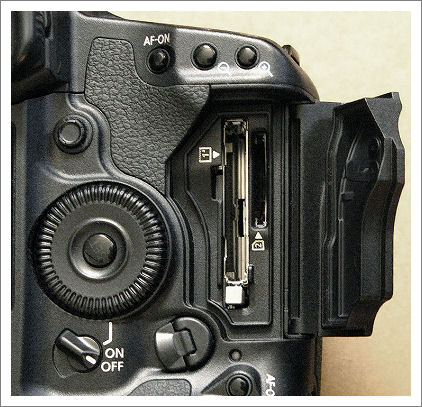
The two cards can be used in a number of different configurations, just as with the 1d MkIII. Still images can be written to either of the cards, or to both simultaneously (video can only be written to one card at a time). There is also an option to write RAW files to one card and simultaneously write JPEGs to the other.
Note: any CF memory camera can utilize both UDMA and non-UDMA cards. If you use a non-UDMA card in the 1D MkIV it's just fine, but data transfer to the card will be a little slower. If you use a UDMA card in a camera like the EOS 5D that does not have UDMA support, it will be fine too, but it won't be able to take advantage of the UDMA transfer protocol.
Battery
The Canon EOS-1D Mark IV's power source is the same lithium-ion LP-E4 Battery Pack as that of the 1D MkIII. Communication between the camera and the LP-E4 Battery Pack enable the battery's remaining capacity to be displayed in one of six levels by the battery check icon shown on the top LCD panel, in the viewfinder (during metering), and on the [Battery info.] menu.
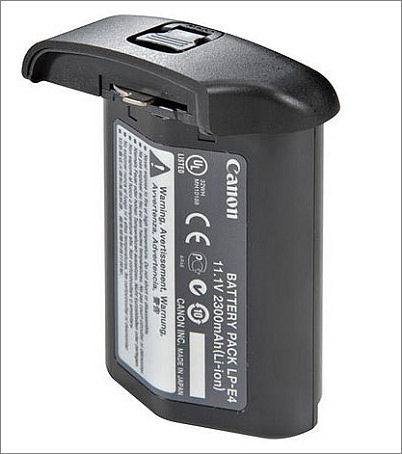
Canon's standard testing suggests that the battery should be good for about 1500 shots at 73°F or 1200 shots at 32°F. In Live View mode those numbers are significantly reduced to 270 and 230 shots respectively. In video mode the battery should be good for about 2h 40m of shooting at 73°F (though there is a 30m or 4GB limit--whichever comes first--on any single video clip).
The supplied battery charger can charge two LP-E4 packs simultaneously.
Conclusion
 |
The Canon EOS 1D MkIV is a remarkable camera, and perhaps at a cost of around $5000 you should expect no less. It's built to a standard to survive hard professional use while delivering images of outstanding quality under adverse conditions. It can shoot at 10 fps and in light levels so low that other cameras would yield images that were mostly noise. I found the autofocus to be fast and accurate and AF tracking of moving subjects was the best I've yet seen. It can also shoot broadcast quality 1080p HD video when called on to do so. It is a large, heavy and complex camera and a thorough reading and understanding of the manual is required to extract the maximum performance via its many customization options (there are 62 custom functions, each of which has from 2 to 4 options). This is not a camera for a beginner, but it is a camera that's capable of yielding outstanding results in the hands of a professional.
If you can afford it and you're prepared to take the time to learn how to use it to its best advantage, the Canon EOS 1D MkIV is highly recommended.
If you found this article interesting, please tell others about it...
